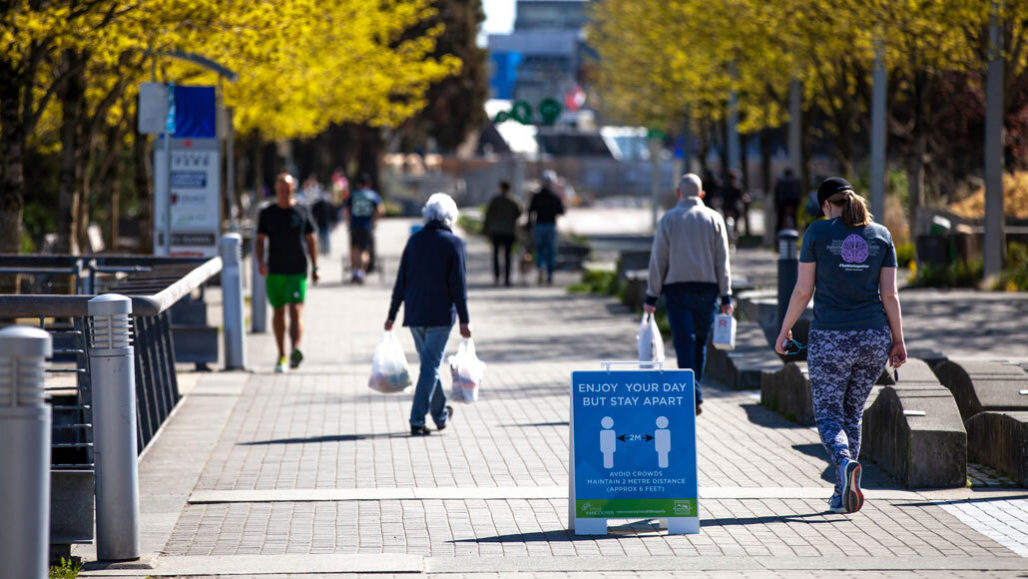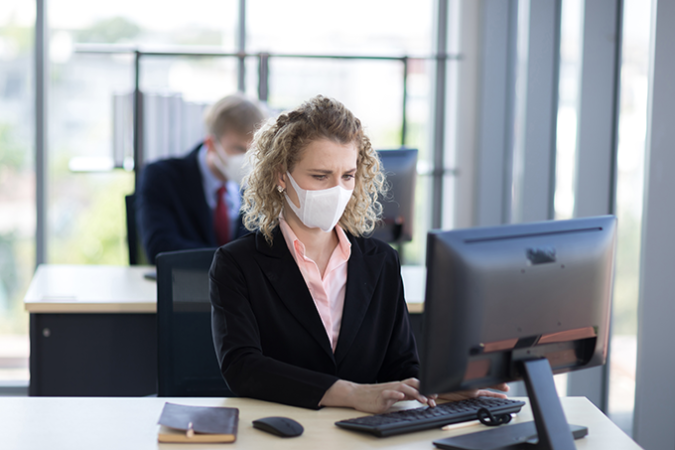Six foot social-distancing will not always be enough for COVID-19
Virus travel can be affected by air movements and how forcefully people speak, data show

A sign in a Vancouver, Canada, park warns pedestrians to stay two meters (six feet) apart to avoid coronavirus infection. But that may not be far enough to be safe under all conditions.
GoToVan/Flickr (CC BY 2.0)
In February, a man in Chicago, Ill., brought food to two friends who had recently lost a family member. He hugged them, too. The next day, the man went to the funeral. There, he comforted other mourners. He also shared a potluck meal with others. A few days later, he attended a family birthday party.
During this time, the man had mild respiratory symptoms. Later he would learn he had COVID-19. His acts of condolence and celebration set off a chain reaction that sickened at least 16 people. Three would end up dying.
At the time, the SARS-CoV-2 virus that causes COVID-19 had not yet spread widely in the Chicago area. Social-distancing measures, therefore, were not yet in place.
This case now serves as a cautionary tale, researchers reported April 8 in Morbidity and Mortality Weekly Report. The viral spread in this incident reinforces why people should keep their distance from anyone outside their immediate household. But how much distance is enough to keep from spreading the coronavirus?
Six feet (or two meters) has become the standard recommendation. The World Health Organization and other experts say that SARS-CoV-2 is spread mainly by large droplets sprayed when people cough or sneeze. These can spew virus particles onto any surface. Touching those surfaces can infect someone. So that 6-foot separation — and frequent hand-washing — was thought to be enough to stop or at least slow the virus’s spread.
New data now challenge that.
If the virus spreads through the air, as scientists now think it may, people may be infected simply by inhaling the virus in tiny droplets of spit released as someone talks or breathes.
How far away must we be to avoid that? No one yet knows. It likely depends on many factors. These could include whether people are inside or out. Or how loudly they are speaking. Or whether they are wearing masks. Or how well-ventilated a room is. It even can depend upon how far the virus can fly.

Educators and Parents, Sign Up for The Cheat Sheet
Weekly updates to help you use Science News Explores in the learning environment
Thank you for signing up!
There was a problem signing you up.
Say it, spray it
When people cough or sneeze, a cloud of droplets of various sizes leaves the mouth or nose, notes Lydia Bourouiba. The same is true when they exhale, talk or sing. A fluid dynamicist, Bourouiba works at the Massachusetts Institute of Technology in Cambridge. There she studies the movement of fluids. This includes air and what it carries. Most computer models of droplet behavior have considered big and small droplets separately. And when it comes to transmitting viruses and other germs, researchers have worried mainly about bigger droplets. These are ones 5 to 10 micrometers in diameter — about the width of a strand of hair — or larger.
Bigger drops can pack in more germs. That gives them a greater chance to infect someone. But bigger droplets also are heavier. So they fall out of the air fairly quickly. Such droplets are thought to rarely travel more than a meter or two (1 to 2 yards) before hitting the ground or other surface.
Sure, someone could cough or sneezes right in your face. But researchers don’t think that’s how most people catch the virus, notes Qingyan Chen. He’s a mechanical engineer at Purdue University in West Lafayette, Ind. His work has been focusing on how infectious diseases spread. Indirect contact might occur when an infected person uses their hand to cover a cough or a sneeze, then touches an object. If an uninfected person now handles that door knob, cup or pen, the virus could transfer to the healthy person’s hands. An unwitting nose scratch, eye rub or finger-food snack could then infect the new person.
That’s why handwashing is so important.
Breathing in smaller airborne droplets exhaled or coughed out may also cause infection. Known as aerosols, these tiny droplets have a hard time overcoming drag (friction) from the air. So they are thought to hang around within a meter (a few feet) of where they were released.
Hence the six-foot rule: It was thought to be far enough to be safe from both occasional long-range spit bullets and invisible clouds of smaller particles.

But maybe not
In fact, droplets spewed from the lungs come in a broad range of sizes. Some are big enough to see with the naked eye. Others are too small for that. Droplets of all sizes can churn through the air, moving as a turbulent cloud, Bourouiba notes.
“This cloud, in fact, changes everything about the dispersal of the drops that you don’t really see,” she says. Breathing, coughing or sneezing propels forward the warm, moist exhaled air within that turbulent cloud. That can now ferry viruses much farther than had been thought. In the case of a sneeze, droplets can travel up to eight meters (23 to 27 feet). Bourouiba presented recent data on this March 26 in JAMA. Even small droplets may therefore spread throughout a room.
Indeed, she concludes: “There’s no reason to believe that the virus only stays in those [droplets] that fall close by.”
Coughs also can propel droplets beyond six feet, evidence suggests. Eric Savory is a fluid mechanics engineer at the University of Western Ontario in London, Canada. Over three flu seasons, his team persuaded sick people to cough into a large box. The goal was to measure how fast and far a cough would spew viruses. Some volunteers had been sick with the flu. Others had respiratory syncytial virus or cold-causing coronaviruses. Some came back after they were feeling better to cough for science again.
Even a meter (yard) from the mouth, coughs are traveling at about a meter per second, the researchers discovered. “It’s not a speed you can avoid by turning your head away,” Savory notes. Volunteers who were either ill, recovered or healthy all coughed at about the same velocity. Results of the study will appear in an upcoming issue of Indoor Air.
Small droplets do slow down as they get farther from the mouth, Savory says. But his data don’t suggest what’s a safe distance. One can simply assume that “you’re lessening your risk [of infection] the farther you are away from someone.”
Size matters
Drops holding infectious SARS-CoV-2 particles can hang around in the air for hours. That’s the finding of a March 17 study in the New England Journal of Medicine. In a lab experiment, researchers used a machine to spew tiny aerosols containing the new coronavirus. Even three hours later, some of those aerosols were still floating in the air. And the viruses in them were still infectious.
That’s not surprising, says William Ristenpart. He’s a chemical engineer at the University of California, Davis. If someone on one side of a large room lights a cigarette, puts on perfume or opens a box of chocolate chip cookies, the smell eventually reaches the other side of the room. “It’s not because [the smoker/perfume wearer/cookie eater is] coughing,” he says. Turbulence created by the mixing of air carries the aerosol around the room.
Ristenpart studies whether flu and other lung infections can spread through the air. COVID-19’s contagiousness is one clue that it might, he says. Researchers at the U.S. National Academies of Science, Engineering and Medicine also concluded in an April 1 report that SARS-CoV-2 might spread through the air.
Add to that the fact that people can spread the virus before they develop symptoms — or without ever developing symptoms. In fact, COVID-19 may be most contagious one to two days before symptoms appear. That’s before people know they are sick.
For instance, almost half of people in Iceland who tested positive for COVID-19 didn’t have symptoms when they were diagnosed. This finding comes from an April 14 report in the New England Journal of Medicine. Many of these people would likely have shown symptoms later, says Kári Stefánsson. He founded deCODE Genetics. It’s a company based in Iceland’s capital city that is screening everyone in that country who wants a test.
By definition, people who don’t have symptoms are not coughing. Or sneezing. But they do talk and breathe.
And sing.
Singing to the choir
Aerosols released as people sing may have led the coronavirus to spread to 45 members of the Skagit Valley Chorale in Washington state. Two of them died.
The singers practiced together on March 3 and 10. This was before their state issued a stay-at-home order. It also was before Skagit County had any known COVID-19 cases. Choir members said they kept a six-foot distance from each other. No one seemed sick. But at least one person must have carried the virus. By belting out tunes, whistling and talking to one another, infected choir members may have propelled the virus into each other’s safety zones.
“A good singer knows how to use all the air in their lungs,” says Donald Milton. He’s an infectious disease specialist. He works at the University of Maryland School of Public Health, in College Park. Belting out that air may also belt out viruses. And breaths taken between phrases by uninfected people may have sucked lots of those viruses deeply into their lungs.
Even just talking face-to-face with an infected person who has no symptoms may be enough to spread the virus. That’s what William Ristenpart at UC Davis and his colleagues propose in an April 3 paper. It appears in Aerosol Science and Technology. Standing six feet apart might cause people to raise their voices to be heard. And talking louder produces more droplets, his group reported last year in Scientific Reports. That’s why he now argues that there’s “a compelling case” to be made that just talking can share infectious viruses.
A new study out of the National Institutes of Health, in Bethesda, Md., supports that idea. It showed that talking releases hundreds of big, wet droplets into the air. In the April 15 New England Journal of Medicine, its authors describe using lasers to visualize those droplets. Ironically, they note, “stay healthy” is a phrase that sprays a lot of saliva.
But that study was not capable of measuring drops smaller than 20 micrometers across, notes Matthew Meselson of Harvard University in Cambridge, Mass. He was not an author of that study. But he did offer a commentary on it that appeared in the same April 15 issue of the New England Journal of Medicine. That minimum size is about the width of a strand of hair. Other studies, he notes, have shown that talking produces thousands of aerosols from the lungs for every saliva droplet from the mouth.
It’s too early to tell whether aerosols and big droplets produce different severities of infection, Meselson says. The pandemic may change how doctors and scientists view the way that respiratory viruses tend to spread, he says. Indeed, he concludes: “I think we’ll find we really were behind the curve when it comes to thinking about how disease is transmitted through the air.”
Going with the flow
Airflow is a big factor in how far droplets — and viruses — spread, says Chen, the Purdue mechanical engineer. Indoors, heating and air conditioning units may draw virus-laden air toward certain parts of a room. But as these systems draw in fresh air, they may also exhaust stale air containing viruses and other particles. This creates a continual flow of air through a room. Ceiling fans and other fans can set up even stronger air flow patterns around a room. Such factors may make it hard to figure out where best to hide from a virus.

It’s a good idea to keep six feet between grocery-store shoppers. Yet there’s nothing magic about that number when it comes to safety, Meselson says. “It’s better than two feet, and 10 feet is better than six.”
Keep in mind, aerosols can linger in air long after a sick shopper has gone home. They can potentially infect workers or people who visit the store later. Advises Meselson, “Try not to go into any enclosed space if you have any reason to believe there was an infected person inside.”
Outside, six feet is probably safer, says Bourouiba. This likely true if both people are wearing masks, have no symptoms and are only talking.
Savory, the Western University engineer who studies coughs, agrees. “The [6-foot] advice that is being given is really sound,” he says. “This distance dramatically reduces the transmission capability of this virus and indeed any virus. If you want to be more safe, you should stay away as far as you can.”
Six feet also may be okay for the huffs and puffs of exercise. True, runners risk stepping into another person’s cloud of exhaled air. However, outdoor breezes may quickly blow those clouds away.
“When you’re walking, you’re walking through your exhaled breath with every step, but it’s quite well diluted,” notes Julian Tang. He’s a virologist and fluid dynamicist at the University of Leicester. That’s in England. There is little side-to-side air movement of air. So stepping off a path as someone walks by should carry little risk, he says.
But the idea of a “safe” distance outdoors depends on if, and which way, the wind is blowing. A breeze may carry virus-laden breath farther than six feet, Milton says. “If there’s a strong breeze blowing, probably nobody should be downwind from each other.”







